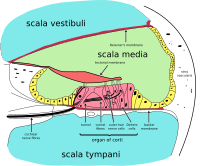Labyrinthine Fistula

A labyrinthine fistula is an abnormal opening in the inner ear. This can result in leakage of the perilymph into the middle ear. This includes specifically a perilymph fistula (PLF), an abnormal connection between the fluid of the inner ear and the air-filled middle ear. This is caused by a rupture of the round window or oval window ligaments separating the inner and middle ear.
Another type of labyrinthine fistula is a semicircular canal dehiscence, which allows the inner ear to be influenced by the intracranial pressure directly.
Signs and symptoms
PLF is a cause of dizziness, imbalance, and hearing loss—any or all of these symptoms can exist. Vertigo (an illusion of motion) is not common in this disorder. The most common cause of this fistula is head or ear trauma. Rapid increases of intracranial pressure can also result in a PLF. Rarely, these fistulas can be congenital, leading to progressive hearing loss and vertigo in childhood. It has also been a complication of a stapedectomy.
Cause
These can be both congenital or develop over time with the thinning of the otic capsule by the persistent pulsations of the intracranial pressures against the bones of the skull. Finally, disease conditions—for example cholesteatoma—can result in a labyrinthine fistula. Traumatic events, with excessive pressure changes to the inner ear such as in scuba diving, head trauma, or an extremely loud noise can lead to rupture and leakage.
Diagnosis
When diagnosing, PLF should be differentiated from Ménière's disease. Tympanostomy has been reported to be a way to diagnose and cure PLF.
Treatment
Patients are advised to treat with bed rest and avoiding activities that increase intracranial pressure (i.e. weightlifting, Valsalva maneuver, scuba diving, flying in airplanes) with the hopes of the membrane healing on their own. Appropriate Physical therapy / vestibular rehabilitation techniques can be helpful in managing symptoms of movement sensitivity.